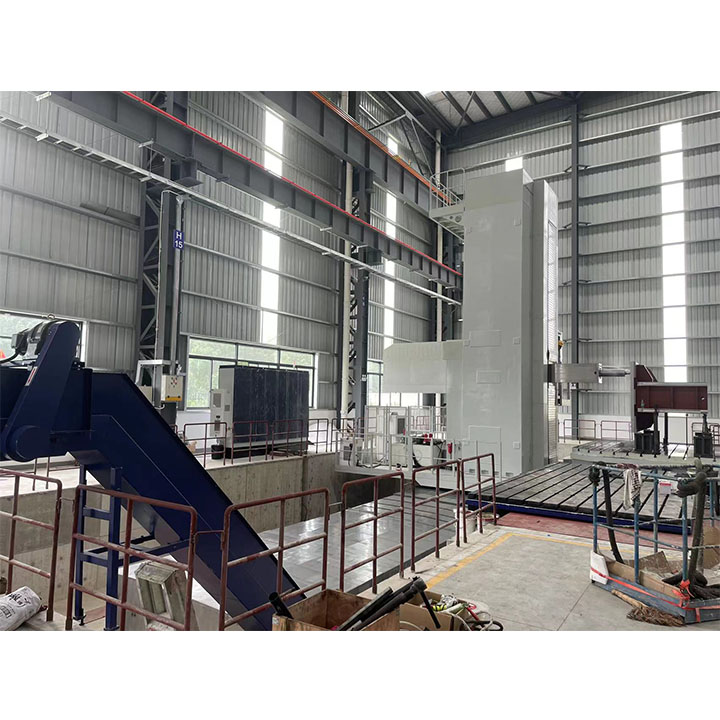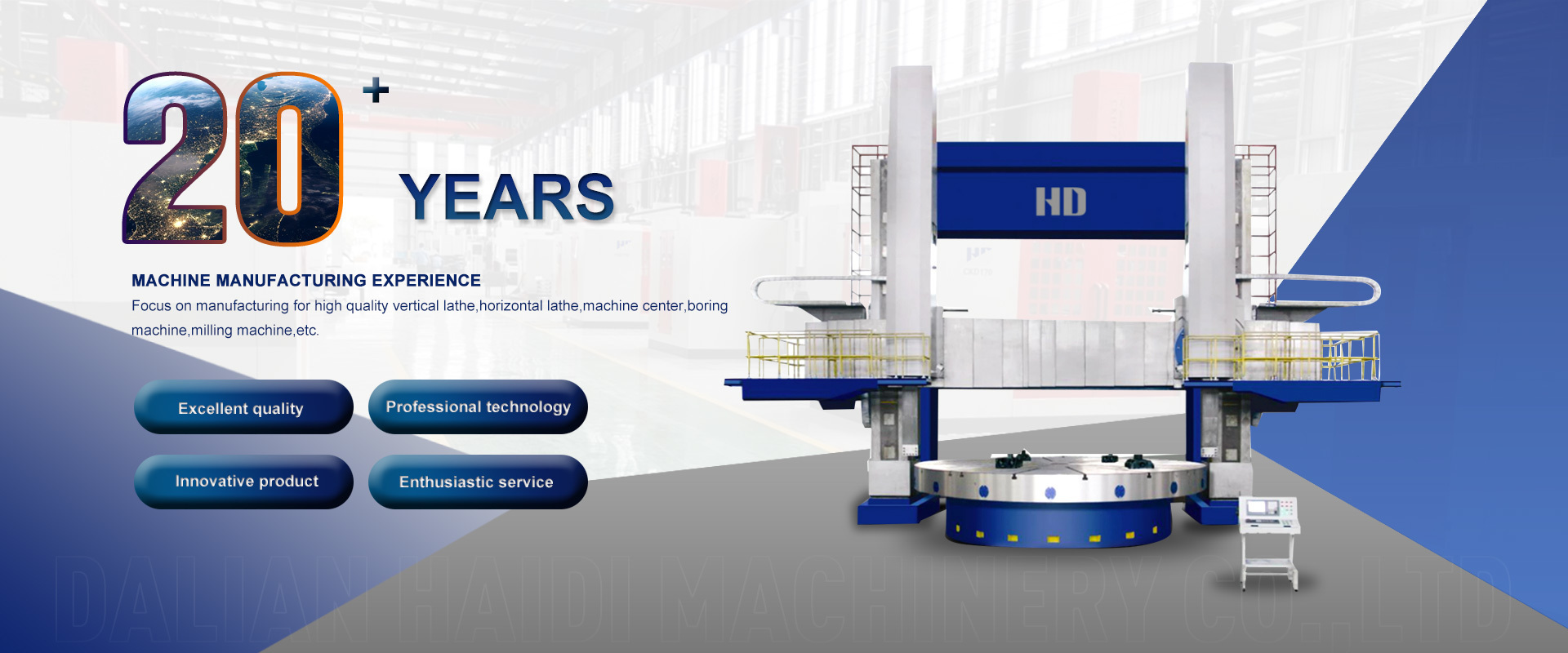14
2025
-
05
Next-Level Heavy Machining: Technical Breakdown of Advanced Floor-Type Boring Mills
Advanced Floor-Type Boring Mills Redefine Heavy-Duty Machining This article highlights the cutting-edge technology and industrial applications of next-gen floor-type boring mills, featuring a 12m X-axis travel, 50-ton load capacity, and ISO-certified precision (0.008mm/2m)—setting new standards for mega-component machining. An AI-driven thermal compensation system with 36 infrared sensors dynamically adjusts micro-deformations, maintaining ±0.02mm accuracy during 24/7 operations. The true 5-axis configuration enables intricate contouring of turbine blades (Ra 0.4μm) and ship propeller hubs without repositioning. Ideal for energy sector applications like 5-8m wind turbine gearboxes and 10m-class hydroelectric runners, the machine also excels in aerospace machining of titanium alloy bulkheads (3mm±0.1mm wall thickness). Key innovations include a polymer-concrete base (92% vibration damping), smart tool management (30% longer insert life), and a regenerative power system recovering 25% of braking energy. These advancements drive efficiency gains and cost reductions for heavy manufacturing.
Next-Level Heavy Machining: Technical Breakdown of Advanced Floor-Type Boring Mills
——Precision Engineering for Mega-Component Manufacturing
Core Technical Specifications
| Parameter | Industry Benchmark | Advanced Floor-Type Boring Mill |
|---|---|---|
| X-Axis Travel | 6,000–8,500 mm | Up to 12,000 mm |
| Spindle Power | 30–45 kW | 55–75 kW (Peak Torque 8,000 Nm) |
| Positioning Accuracy | 0.015 mm/2m | 0.008 mm/2m (ISO 230-2 Certified) |
| Max Workpiece Weight | 15–25 metric tons | 35–50 metric tons |
| Rapid Traverse | 15–30 m/min | 50 m/min (Linear Motor Options) |

5 Game-Changing Technological Advantages
1. AI-Driven Thermal Stability
-
36-Point Thermal Compensation System
Infrared sensors embedded in columns, crossrails, and spindle housings detect micro-deformations (as small as 2μm). Machine learning algorithms adjust positioning in real-time, maintaining ±0.02mm accuracy during 24/7 operations. -
Cooling Innovation
Dual-circuit oil-air cooling reduces spindle thermal drift by 78% compared to conventional systems.
2. Multi-Axis Machining Capability
-
True 5-Axis Configuration
B-axis (±30° tilt) + C-axis (n×360° rotation) enables complex contour machining without repositioning. Ideal for:
➔ Turbine blade root profiles (Ra 0.4μm achievable)
➔ Ship propeller hubs with helical geometries -
Synchronized Motion Control
0.0001° resolution rotary tables coordinate with linear axes for true simultaneous 5-axis cutting.
3. Heavy-Duty Structural Design
-
Polymer-Concrete Hybrid Base
Damping coefficient of 92% eliminates vibration in deep boring operations (e.g., 3m-depth wind turbine main bearing housings). -
Reinforced Box-in-Box Construction
Triple-walled columns withstand 50-ton cutting forces while maintaining 0.01mm/m straightness.
4. Intelligent Process Optimization
-
Adaptive Machining Module
Automatically adjusts feed rates (up to 8,000 mm/min) and spindle loads based on real-time cutting force monitoring. -
Tool Life Prediction
Vibration sensors detect insert wear patterns, extending tool usage by 30–45%.
5. Energy-Efficient Operation
-
Regenerative Power Systems
Recovers 25% of braking energy to power auxiliary systems, reducing total energy consumption by 18–22%.
Target Applications & Industry Solutions
1. Energy Sector
-
Wind Turbine Components
-
Gearbox housings (5–8m diameter)
-
Nacelle frames (flatness ≤0.03mm/m)
-
-
Hydroelectric Systems
-
Turbine runners (6–10m diameter)
-
Stay ring profiling (true position ±0.05mm)
-
2. Aerospace & Defense
-
Rocket Engine Parts
-
Combustion chambers (Inconel 718)
-
Titanium alloy bulkheads (wall thickness 3mm±0.1mm)
-
-
Landing Gear Components
-
High-strength steel trunnions (HRC 50+)
-
3. Marine & Offshore
-
Propulsion Systems
-
10m+ diameter propeller hubs
-
Stern tube boring (straightness 0.015mm/m)
-
-
Drilling Equipment
-
Offshore platform riser flanges (ASME B16.5 compliance)
-
Operational Cost Analysis
| Cost Factor | Traditional Boring Mill | Advanced Model | Savings |
|---|---|---|---|
| Tooling Expenses | $18,000/month | $12,500/month | 30% |
| Energy Consumption | 145 kWh/hour | 108 kWh/hour | 25% |
| Setup Time | 4.5 hours/job | 1.2 hours/job | 73% |
| Scrap Rate | 2.8% | 0.6% | 79% |
Implementation Checklist
Before deploying a floor-type boring mill:
-
Facility Preparation
-
Ensure 15-ton/m² floor loading capacity
-
Maintain ambient temperature 20°C±2°C
-
-
Workholding Strategy
-
For 8m+ components: 4-point hydraulic clamping system required
-
-
Cutting Tool Selection
-
200–250mm boring bars with anti-vibration dampers
-
PCD inserts for non-ferrous alloys
-
Related news



